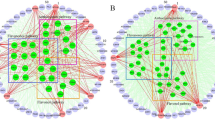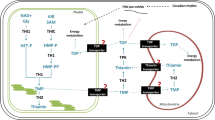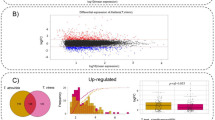Abstract
Thiamine (vitamin B1) is an essential compound for organisms. It contains a pyrimidine ring structure and a thiazole ring structure. These two moieties of thiamine are synthesized independently and then coupled together. Here we report the molecular characterization of AtTHIC, which is involved in thiamine biosynthesis in Arabidopsis. AtTHIC is similar to Escherichia coli ThiC, which is involved in pyrimidine biosynthesis in prokaryotes. Heterologous expression of AtTHIC could functionally complement the thiC knock-out mutant of E. coli. Downregulation of AtTHIC expression by T-DNA insertion at its promoter region resulted in a drastic reduction of thiamine content in plants and the knock-down mutant thic1 showed albino (white leaves) and lethal phenotypes under the normal culture conditions. The thic1 mutant could be rescued by supplementation of thiamine and its defect functions could be complemented by expression of AtTHIC cDNA. Transient expression analysis revealed that the AtTHIC protein targets plastids and chloroplasts. AtTHIC was strongly expressed in leaves, flowers and siliques and the transcription of AtTHIC was downregulated by extrinsic thiamine. In conclusion, AtTHIC is a gene involved in pyrimidine synthesis in the thiamine biosynthesis pathway of Arabidopsis, and our results provide some new clues for elucidating the pathway of thiamine biosynthesis in plants.
Similar content being viewed by others
Log in or create a free account to read this content
Gain free access to this article, as well as selected content from this journal and more on nature.com
or
References
Begley TP . The biosynthesis and degradation of thiamine (vitamin B1). Nat Prod Rep 1996; 13:177–185.
Burdick R. Thiamine . In: Howe-Grant M, ed. Kirk-Othmer encyclopedia of chemical technology, Wiley Press: New York 1998; 25:152–171.
Nosaka K . Recent progress in understanding thiamine biosynthesis and its genetic regulation in Saccharomyces cerevisiae. Appl Microbiol Biotechnol 2006; 72:30–40.
Spenser ID, White RL . Biosynthesis of vitamin B1 (thiamine): An instance of biochemical diversity. Angew Chem Int Ed Engl 1997; 36:1032–1046.
Estramareix B, Therisod M . Tyrosine as a factor of biosynthesis of the thiazole moiety of thiamine in Escherichia coli. Biochim Biophys Acta 1972; 273:275–282.
Bellion E, Kirkley DH, Faust JR . The biosynthesis of the thiazole moiety of thiamine in Salmonella typhimurium. BBA-Gen Subjects 1976; 437:229–237.
White RH, Rudolph FB . The origin of the nitrogen atom in the thiazole ring of thiamine in Escherichia coli. Biochim Biophys Acta 1978; 542:340–347.
DeMoll E, Shive W . Determination of the metabolic origin of the sulfur atom in thiamine of Escherichia coli by mass spectrometry. Biochem Biophys Res Commun 1985; 132:217–222.
Tazuya K, Yamada K, Nakamura K, Kumaoka H . The origin of the sulfur atom of thiamine. Biochim Biophys Acta 1987; 924:210–215.
Webb E, Downs D . Characterization of thiL, Encoding thiamine-monophosphate Kinase, in Salmonella typhimurium. J Biol Chem 1997; 272:15702–15707.
Kinsland C, Taylor SV, Kelleher NL, McLafferty FW, Begley TP . Overexpression of recombinant proteins with a C-terminal thiocarboxylate: Implications for protein semisynthesis and thiamine biosynthesis. Protein Sci 1998; 7:1839–1842.
Taylor SV . Thiamine biosynthesis in E. coli: biosynthesis of the thiazole moiety. PhD thesis. Cornell University, Ithaca, NY, 1998.
Taylor SV, Kelleher NL, Kinsland C, et al. Thiamine biosynthesis in Escherichia coli. Identification of this thiocarboxylate as the immediate sulfur donor in the thiazole formation. J Biol Chem 1998; 273:16555–16560.
Begley TP, Diana MD, Steven EE, et al. Thiamine biosynthesis in prokaryotes. Arch Microbiol 1999; 171:293–300.
Costello C . Mechanistic studies on thiamine biosynthesis in E.coli and thiamine degradation in B. thiaminolyticus. PhD thesis. Cornell University, Ithaca, NY, 1996.
Zhang Y, Begley TP . Cloning, sequencing and regulation of thiA, a thiamine biosynthesis gene from Bacillus subtilis. Gene 1997; 198:73–82.
Zhang Y, Taylor SV, Chiu HJ, Begley TP . Characterization of the Bacillus subtilis thiC operon involved in thiamine biosynthesis. J Bacteriol 1997; 179:3030–3035.
Vander Horn PB, Backstrom AD, Stewart V, Begley TP . Structural genes for thiamine biosynthetic enzymes (thiCEFGH) in Escherichia coli K-12. J Bacteriol 1993; 175:982–992.
Backstrom AD, McMordie RAS, Begley TP . Biosynthesis of thiamine I: The function of the thiE gene product. J Am Chem Soc 1995; 117:2351–2352.
Kelleher NL, Taylor SV, Grannis D, et al. Efficient sequence analysis of the six gene products (7-74 kDa) from the Escherichia coli thiamine biosynthetic operon by tandem high-resolution mass spectrometry. Protein Sci 1998; 7:1796–1801.
Webb E, Febres F, Downs DM . Thiamine pyrophosphate (TPP) negatively regulates transcription of some thi genes of Salmonella typhimurium. J Bacteriol 1996; 178:2533–2538.
Rodríguez-Navarro S, Llorente B, Rodríguez-Manzaneque MT, et al. Functional analysis of yeast gene families involved in metabolism of vitamin B1. Yeast 2002; 19:1261–1276.
Wightman R, Meacock PA . The THI5 gene family of Saccharomyces cerevisiae: distribution of homologues among the hemiascomycetes and functional redundancy in the aerobic biosynthesis of thiamine from pyridoxine. Microbiology 2003; 149:1447–1460.
Li SL, Rédei GP . Thiamine mutants of the crucifer, Arabidopsis. Biochem Gene 1969; 3:163–170.
Kumar S, Sharma SB . Mutations in three of the genes determining thiamine biosynthesis in Pisum sativum. MGG 1986; 204:473–476.
Proebsting WM, Maggard SP, Guo WW . The relationship of thiamine to the Alt locus of Pisum sativum L. J Plant Physiol 1990; 136:231–235.
Koornneef M, Hanhart CJ . Arabidopsis Information Service 18. 1981; http://www.Arabidopsis.org/ais/1981/koorn-1981-aactn.html.
Machado CR, Costa de Oliveira RL, Boiteux S, Praekelt UM, Meacock PA, Menck CFM . Thi1, a thiamine biosynthetic gene in Arabidopsis thaliana, complements bacterial defects in DNA repair. Plant Mol Biol 1996; 31:585–593.
Ribeiro A, Praekelt U, Akkermans ADL, et al. Identification of agthi1, whose product is involved in biosynthesis of the thiamine precursor thiazole, in actinorhizal nodules of Alnus glutinosa. Plant J 1996; 10:361–368.
Ajjawi I, Tsegaye Y, Shintani D . Determination of the genetic, molecular, and biochemical basis of the Arabidopsis thaliana thiamine auxotroph th1. Arch Biochem Biophys 2007; 459:107–114.
Chabregas SM, Luche DD, Farias LP, et al. Dual targeting properties of the N-terminal signal sequence of Arabidopsis thaliana THI1 protein to mitochondria and chloroplasts. Plant Mol Biol 2001; 46:639–650.
Chabregas SM, Luche DD, van Sluys MA, Menck CF, Silva-Filho MC . Differential usage of two in-frame translational start codons regulates subcellular localization of Arabidopsis thaliana THI1. J Cell Sci 2002; 116:285–291.
Kim YS, Nosaka K, Diana MD, et al. A Brassica cDNA clone encoding a bifunctional hydroxymethylpyrimidine kinase/thiamin-phosphate pyrophosphorylase involved in thiamine biosynthesis. Plant Mol Biol 1998; 37:955–966.
Raschke M, Burkle L, Muller N, et al. Vitamin B1 biosynthesis in plants requires the essential iron sulfur cluster protein, THIC. Proc Natl Acad Sci USA 2007; 104:19637–19642.
Julliard J, Douce R . Biosynthesis of the thiazole moiety of thiamine (vitamin B1) in higher plant chloroplasts. Proc Natl Acad Sci USA 1991; 88:2042–2045.
Faith CB, Thomas L, Boyang C, Alan LK . Evidence for the thiamine biosynthetic pathway in higher-plant plastids and its developmental regulation. Plant Mol Biol 1995; 29:809–821.
Miranda-Ríos J, Navarro M, Soberón M . A conserved RNA structure (thi box) is involved in regulation of thiamine biosynthetic gene expression in bacteria. Proc Natl Acad Sci USA 2001; 98:9736–9741.
Mironov AS, Gusarov I, Rafikov R, et al. Sensing small molecules by nascent RNA: A mechanism to control transcription in bacteria. Cell 2002; 111:747–756.
Winkler W, Nahvi A, Breaker RR . Thiamine derivatives bind messenger RNAs directly to regulate bacterial gene expression. Nature 2002; 419:952–956.
Lai EC . RNA sensors and riboswitches: self-regulating messages. Curr Biol 2003; 13:285–291.
Sudarsan N, Barrick JE, Breaker RR . Metabolite-binding RNA domains are present in the genes of eukaryotes. RNA 2003; 9:644–647.
Sambrook J, Russell DW, eds. Moleular cloning: a laboratory manual. Cold Spring Harbor Laboratory Press, 2001.
Van Engelen FA, Molthoff JW, Conner AJ, Nap JP, Pereira A, Stiekema WJ . pBINPLUS: an improved plant transformation vector based on pBIN19. Transgenic Res 1995; 4:288–290.
Clough SJ, Bent AF . Floral dip: a simplified method for Agrobacterium-mediated transformation of Arabidopsis thaliana. Plant J 1998; 16:735–743.
Jefferson RA, Kavanagh TA, Bevan MW . Assaying chimeric genes in plants: The GUS gene fusion system. Plant Mol Biol Rep 1987; 5:387–405.
Church GM, Gilbert W . Genomic Sequencing. Proc Natl Acad Sci USA 1984; 81:1991–1995.
Li L, Cheng X, Ling HQ . Isolation and characterization of Fe(III)-chelate reductase gene LeFRO1 in tomato. Plant Mol Biol 2004; 54:125–136.
Liu X, Liu X, Zhang J, et al. Molecular and functional characterization of sulfiredoxin homologs from higher plants. Cell Res 2006; 16:287–296.
Weigel D, Glazebrook J, eds. Arabidopsis: a Laboratory Manual. New York: Cold Spring Harbor Laboratory Press, 2002.
Shah K, Russinova E, Gadella TW Jr, Willemse J, de Vries SC . The Arabidopsis kinase-associated protein phosphatase controls internalization of the somatic embryogenesis receptor kinase 1. Genes Dev 2002; 16:1707–1720.
Acknowledgements
This work was supported by the National Natural Science Foundation of China (grant numbers 30530460 and 30521001), the Ministry of Science and Technology of China (grant numbers 2005cb20904 and 2006AA10A105) and the Chinese Academy of Sciences (grant number KSCX2-YW-N-001).
Author information
Authors and Affiliations
Corresponding author
Rights and permissions
About this article
Cite this article
Kong, D., Zhu, Y., Wu, H. et al. AtTHIC, a gene involved in thiamine biosynthesis in Arabidopsis thaliana. Cell Res 18, 566–576 (2008). https://doi.org/10.1038/cr.2008.35
Received:
Revised:
Accepted:
Published:
Issue date:
DOI: https://doi.org/10.1038/cr.2008.35
Keywords
This article is cited by
-
OsTH1 is a key player in thiamin biosynthesis in rice
Scientific Reports (2024)
-
Roles and maturation of iron–sulfur proteins in plastids
JBIC Journal of Biological Inorganic Chemistry (2018)
-
Both overexpression and suppression of an Oryza sativa NB-LRR-like gene OsLSR result in autoactivation of immune response and thiamine accumulation
Scientific Reports (2016)
-
Site-directed mutagenesis of the Arabidopsis heterotrimeric G protein β subunit suggests divergent mechanisms of effector activation between plant and animal G proteins
Planta (2012)



